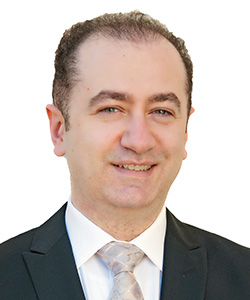Regenerative Therapies for Arthritis: Mechanisms of Analgesia
Cite as: Buchheit T, Eshraghi Y. Regenerative therapies for arthritis: mechanisms of analgesia. ASRA News 2021;46. https://doi.org/10.52211/asra080121.051.
Osteoarthritis is the most significant cause of disability and economic burden in older adults1; as patients search for effective nonsurgical remedies, intra-articular regenerative therapies are an increasingly common option. These biologically based treatments include cellular products derived from bone marrow, lipid, and other tissues, and blood-derived products such as platelet-rich plasma (PRP) and autologous conditioned serum (ACS).
Inflammation serves as a driver of osteoarthritic pain and is a frequent target for research and therapy; 2,3 catabolic cytokines such as TNF, IL-1 and enzymes such as matrix metalloproteinases are associated with pain and joint degeneration; 4,5 conversely, anabolic cytokines such as IL1-Ra (an inhibitor of IL-1), TGF-ß, IL-10, and others are protective for joint tissue.6,7 It is the proper balance of these factors that is the goal of regenerative medicine.
PRP and Growth Factors
Platelets contain over 300 growth factors such as transforming growth factor-ß (TGF-ß), platelet-derived growth factor, fibroblastic growth factor, hepatocyte growth factor, epidermal growth factor, and others.8-10 In most PRP preparations, white blood cells (WBCs) such as neutrophils and monocytes are also present in varying concentrations. WBCs may provide a pro-inflammatory stimulus,11 but also play a role in repair mechanisms after injection. In particular, monocytes and macrophages may function as inflammatory cells or inflammation-resolving cells and are capable of activating a therapeutic response through growth factor expression and recruitment of endogenous hematopoetic stem cells to the site of delivery. 12–14 The evidence supporting PRP’s therapeutic benefit in arthritis pain is increasingly established but variable depending on the specific indication. 15,16
ACS, Anti-Inflammatory Cytokines, and Growth Factors
In the 1990s, investigators found that incubated whole blood was a significant source of anabolic cytokines such as IL1-Ra, IL-4, IL-10, and TGF-β. 7,17 More recent research findings show that the incubation process as well as cell culturing may induce the production of exosome-containing micro-RNA that drives beneficial epigenetic changes in the target tissue.18, 19 ACS has demonstrated longer-term benefit in knee7,20,21 as well as hip arthritis.22
Mesenchymal (Stem) Cell Therapies and Immune Modulation
Mesenchymal cells may be derived from multiple sources, including bone marrow, adipose, and umbilical cord, and are often described as MSCs, a broad acronym that signifies either mesenchymal stem cells, mesenchymal stromal cells, or medicinal signaling cells. 23,24 The cell lines may differentiate to cartilage, muscle, and bone, given appropriate cell culture media,24,25 although in clinical use, MSCs often are injected immediately after harvest (non-cultured cells). Meta-analyses support a positive analgesic response for the treatment of knee OA,26-27 and observational data suggest improvements in cartilage health following treatment with culture-expanded MSCs;28,29 however, it does not appear that tissue engraftment occurs, particularly with non-cultured cells.
Recent study findings increasingly support the importance of cytokine and immune activity in the therapeutic response following MSC treatment to an arthritic joint.30-33 These immune mechanisms of action have been further clarified with the experimental use of infused MSCs that induce a phenotypic change in circulating macrophages, subsequently upregulating anabolic and anti-inflammatory cytokines such as IL10 and TGF-b.34 Furthermore, it is possible to reverse the analgesia of cultured laboratory MSCs with the use of an antibody to TGF-b.35 Clinically, this immune-driven analgesic mechanism is supported by a study demonstrating that the majority of patients who experienced positive clinical outcomes after MSC injection had no improvement in cartilage abnormality.36
Conclusion
Despite the diversity of methods and applications used in regenerative pain medicine, common analgesic processes—including growth factor augmentation, immune modulation, and epigenetic target-cell changes—likely play a critical part in outcomes following the application MSCs, PRP, and ACS as well as other biologically based treatments. Regenerative medicine holds great promise in the treatment of degenerative musculoskeletal conditions, but more work is needed to clarify the fundamental mechanisms common to these evolving arthritis treatments.

Thomas Buchheit, MD, is the director of Regenerative Pain Therapies at the Center for Translational Pain Medicine in the department of Anesthesiology at Duke University and Durham Veterans Affairs Health Care System in Durham, NC.

Yashar Eshraghi, MD is the medical director of Pain Research, assistant program director of the Pain Medicine Fellowship Training Program, and assistant professor in the department of Anesthesiology and Critical Care Medicine at Ochsner Health System at the University of Queensland Ochsner Medical School. He is also a clinical assistant professor at Louisiana State University School of Medicine in New Orleans.
References
- Hunter DJ, Bierma-Zeinstra S. Osteoarthritis. Lancet 2019;393(10182):1745-59. https:/doi.org/10.1016/S0140-6736(19)30417-9.
- Miller RE, Miller RJ, Malfait A-M. Osteoarthritis joint pain: the cytokine connection. Cytokine 2014;70(2):185–93. https://doi.org/10.1016/j.cyto.2014.06.019.
- Cuellar JM, Scuderi GJ, Cuellar VG, et al. Diagnostic utility of cytokine biomarkers in the evaluation of acute knee pain. J Bone Joint Surg Am 2009;91(10):2313–20. https://doi.org/10.2106/jbjs.h.00835.
- Buchheit T, Huh Y, Maixner W, Cheng J, Ji R-R. Neuroimmune modulation of pain and regenerative pain medicine. J Clin Invest 2020; 130(5): 2164-76. https://doi.org/10.1172/JCI134439.
- Martel-Pelletier J, McCollum R, DiBattista J, et al. The interleukin-1 receptor in normal and osteoarthritic human articular chondrocytes: identification as the type I receptor and analysis of binding kinetics and biologic function. Arthritis Rheum 1992;35(5):530–40. https://doi.org/10.1002/art.1780350507.
- Pujol J-P, Chadjichristos C, Legendre F, et al. Interleukin-1 and transforming growth factor-ß 1 as crucial factors in osteoarthritic cartilage metabolism. Connect Tissue Res 2009;49(3-4):293–7. https://doi.org/10.1080/03008200802148355.
- Evans CH, Chevalier X, Wehling P. Autologous conditioned serum. Phys Med Rehabil Clin N Am 2016;27(4):893–908. https://doi.org/10.1016/j.pmr.2016.06.003.
- Hickey DG, Frenkel SR, DiCesare PE. Clinical applications of growth factors for articular cartilage repair. Am J Orthop 2003;32(2):70-6.
- Blair P, Flaumenhaft R. Platelet alpha-granules: basic biology and clinical correlates. Blood Rev 2009;23(4):177-89. https://doi.org/10.1016/j.blre.2009.04.001.
- Xie X, Zhang C, Tuan RS. Biology of platelet-rich plasma and its clinical application in cartilage repair. Arthritis Res Ther 2014;16(1): 204. https://doi.org/10.1186/ar4493.
- Andia I, Maffulli N. Platelet-rich plasma for managing pain and inflammation in osteoarthritis. Nat Rev Rheumatol 2013;9(12):721-30. https://doi.org/10.1038/nrrheum.2013.141.
- Baay M, Brouwer A, Pauwels P, et al. Tumor cells and tumor-associated macrophages: secreted proteins as potential targets for therapy. Clin Dev Immunol 2011;2011:565187. https://doi.org/10.1155/2011/565187.
- Crane JL, Cao X. Bone marrow mesenchymal stem cells and TGF-β signaling in bone remodeling. J Clin Invest 2014;124(2):466–72. https://doi.org/10.1172/jci70050.
- Le Blanc K, Mougiakakos D. Multipotent mesenchymal stromal cells and the innate immune system. Nat Rev Immunol 2012;12(5):383–96. https://doi.org/10.1038/nri3209.
- Dai WL, Zhou AG, Zhang H, et al. Efficacy of platelet-rich plasma in the treatment of knee osteoarthritis: a meta-analysis of randomized controlled trials. Arthroscopy 2017;33(3):659–70.e1. https://doi.org/10.1016/j.arthro.2016.09.024.
- Meheux CJ, McCulloch PC, Lintner DM, et al. Efficacy of intra-articular platelet-rich plasma injections in knee osteoarthritis: a systematic review. Arthroscopy 2016;32(3):495–505. https://doi.org/10.1016/j.arthro.2015.08.005.
- Meijer H, Reinecke J, Becker C, et al. The production of anti-inflammatory cytokines in whole blood by physico-chemical induction. Inflamm Res 2003;52(10):404–7. https://doi.org/10.1007/s00011-003-1197-1.
- Sui BD, Zheng CX, Li M, Jin Y, Hu CH. Epigenetic regulation of mesenchymal stem cell homeostasis. Trends Cell Biol 2020;30(2):97-116. https://doi.org/0.1016/j.tcb.2019.11.006.
- Shirokova K, Noskov S, Gorokhova V, et al. Intra-articular injections of a whole blood-clot secretome, autologous conditioned serum, have superior clinical and biochemical efficacy over platelet-rich plasma and induce rejuvenation-associated changes of joint metabolism. A prospective, controlled, open label clinical study in knee osteoarthritis. Rejuvenation Res 2020;23(5):401–10. https://doi.org/10.1089/rej.2019.2263.
- Baltzer AWA, Moser C, Jansen SA, et al. Autologous conditioned serum (Orthokine) is an effective treatment for knee osteoarthritis. Osteoar Cartilage 2009;17(2):152–60. https://doi.org/10.1016/j.joca.2008.06.014.
- García-Escudero JB, Trillos PMH. Treatment of osteoarthritis of the knee with a combination of autologous conditioned serum and physiotherapy: a two-year observational study. PLoS One 2015;10(12):e0145551. https://doi.org/10.1371/journal.pone.0145551.
- Baltzer AWA, Ostapczuk MS, Stosch D, et al. A new treatment for hip osteoarthritis: clinical evidence for the efficacy of autologous conditioned serum. Orthop Rev 2013;5(2):e13. https://doi.org/10.4081/or.2013.e13.
- Caplan AI. Mesenchymal stem cells: time to change the name! Stem Cell Transl Med 2017;6(6):1445–51. https://doi.org/10.1002/sctm.17-0051.
- Squillaro T, Peluso G, Galderisi U. Clinical trials with mesenchymal stem cells: an update. Cell Transplant 2016;25(5):829–48. https://doi.org/10.3727/096368915x689622.
- Sato M, Uchida K, Nakajima H, et al. Direct transplantation of mesenchymal stem cells into the knee joints of Hartley strain guinea pigs with spontaneous osteoarthritis. Arthritis Res Ther 2012;14(1):R31. https://doi.org/10.1186/ar3735.
- Ding W, Xu YQ, Zhang Y, Li A-X, Qui X, Wen H-J, Tan H-B. Efficacy and safety of intra-articular cell-based therapy for osteoarthritis: systematic review and network meta-analysis. Cartilage 2020;1947603520942947. https://doi.org/10.1177/1947603520942947.
- Kim SH, Djaja YP, Park Y-B, Park J-G, Ko Y-B, Ha C-W. Intra-articular injection of culture-expanded mesenchymal stem cells without adjuvant surgery in knee osteoarthritis: a systematic review and meta-analysis." Am J Sports Med 2020;48(11): 2839-49. https://doi.og/10.1177/0363546519892278.
- Vangsness CT, Jr., Farr J, 2nd, Boyd J, et al. Adult human mesenchymal stem cells delivered via intra-articular injection to the knee following partial medial meniscectomy: a randomized, double-blind, controlled study. J Bone Joint Surg Am 2014;96(2):90–8. https://doi.org/10.2106/JBJS.M.00058.
- Soler R, Orozco L, Munar A, et al. Final results of a phase I–II trial using ex vivo expanded autologous mesenchymal stromal cells for the treatment of osteoarthritis of the knee confirming safety and suggesting cartilage regeneration. Knee 2016;23(4):647–54. https://doi.org/10.1016/j.knee.2015.08.013.
- Caplan AI, Dennis JE. Mesenchymal stem cells as trophic mediators. J Cell Biochem 2006;98(5):1076–84. https://doi.org/10.1002/jcb.20886.
- Pers YM, Ruiz M, Noel D, et al. Mesenchymal stem cells for the management of inflammation in osteoarthritis: state of the art and perspectives. Osteoarthr Cartilage 2015;23(11):2027-35. https://doi.org/10.1016/j.joca.2015.07.004.
- Castro-Manrreza ME, Montesinos JJ. Immunoregulation by mesenchymal stem cells: biological aspects and clinical applications. J Immunol Res 2015;2015:394917. https://doi.org/10.1155/2015/394917.
- Murphy MB, Moncivais K, Caplan AI. Mesenchymal stem cells: environmentally responsive therapeutics for regenerative medicine. Exp Mol Med 2013;45:e54. https://doi.org/10.1038/emm.2013.94.
- de Witte SFH, Luk F, Sierra Parraga JM, et al. Immunomodulation by therapeutic mesenchymal stromal cells (msc) is triggered through phagocytosis of msc by monocytic cells. Stem Cells 2018;36(4):602–15. https://doi.org/10.1002/stem.2779.
- Chen G, Park CK, Xie RG, et al. Intrathecal bone marrow stromal cells inhibit neuropathic pain via TGF-beta secretion. J Clin Invest 2015;125(8):3226–40. https://doi.org/10.1172/JCI80883.
- Koh YG, Choi YJ, Kwon OR, et al. Second-Look arthroscopic evaluation of cartilage lesions after mesenchymal stem cell implantation in osteoarthritic knees. Am J Sports Med 2014;42(7):1628–37. https://doi.org/10.1177/0363546514529641.
Leave a commentOrder by
Newest on top Oldest on top